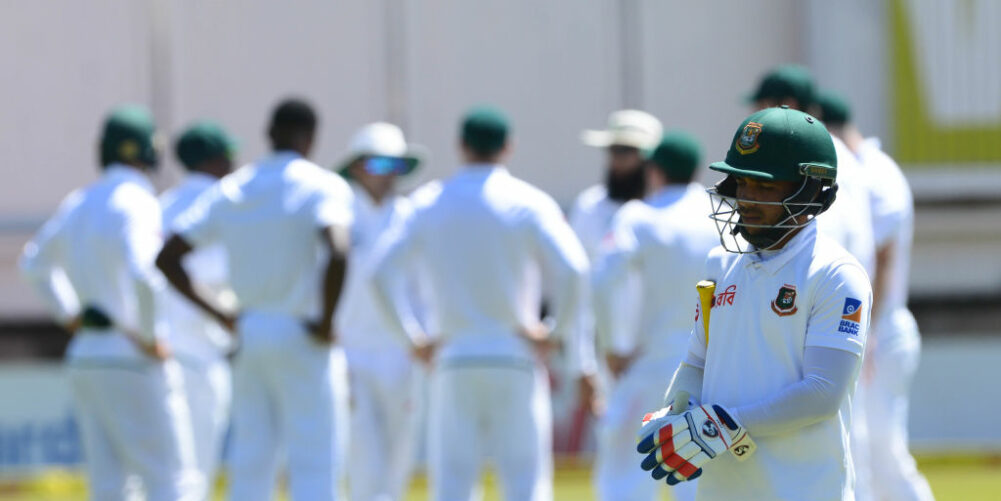By Tim Wigmore
A few months ago, Shakib Al Hasan, the greatest cricketer in Bangladesh’s history, declared: “We are very much unbeatable at home,” before the visit of Australia.
Shakib was wrong. After besting Australia in the first Test, Bangladesh floundered in the second; the series was drawn 1-1.
And yet his broader point remains correct: in the right conditions Bangladesh are now a formidable international cricket side. Since the 2015 World Cup, they have been on a run of six straight ODI series victories at home; beaten England in a Test (while losing narrowly in the other); shared a Test series 1-1 away to Sri Lanka; and then beaten Australia at home.
They were also very competitive during a solitary Test in India in February and authored a spectacular victory against New Zealand in Cardiff to, somewhat fortuitously, reach the Champions Trophy semi-finals.
When the words “tour to Bangladesh” are uttered, they are no longer synonymous with ‘easy tour’. Indeed, in home conditions, Bangladesh would rightly consider themselves at least equal favourites against all opponents bar India. Bangladesh’s rise has been one of the great stories in international cricket over the past two years.
The trouble is, this rise is only half-complete. Bangladesh have moved from being makeweights in international cricket to a Jekyll and Hyde team, formidable at home and yet meek away from Sub-continental conditions. For all their strides in suitable conditions, Bangladesh continue to be exposed on wickets that seam, bounce and don’t assist spin bowling.
How that has been evident during the tour to South Africa, a return to Bangladesh’s bad old days. Consider their results.
In the two Test matches, Bangladesh lost by 333 runs and then an innings and 254 runs. They took only 13 South African wickets in the series and, after scoring 320 in their first innings, their batting subsided thereafter, scoring 90, 147 and 172.
Nor were the ODIs any better. South Africa won by 10 wickets in the opening game, when Bangladesh were defending 278 yet couldn’t muster a single wicket. They then lost by 104 and 100 runs in the final two games. Bangladesh eviscerated.
Their last series in unfamiliar climes ended in the same result: a whitewash in both the Tests and ODIs. Bangladesh’s batting was far better in those Tests in New Zealand, yet the point remains: Bangladesh away from home are a pitiful imitation of the heavyweight team at home.
What can be done? The contrasting results reflects how Bangladesh are far better at playing against, and bowling, spin, than they are playing against, and bowling, pace. Consider Rubel Hossain’s record over 25 – 25! – Test matches: 33 wickets at 79.00 apiece, stats unworthy of an occasional bowler.
To remedy their weaknesses, Bangladesh need to prioritise pace bowling. That should start with the pitches at home. Bangladesh are right to focus on their strengths when opponents tour, and produce wickets that turn prodigiously, but they need some wickets at home to offer pace and bounce in domestic cricket, aiding the development of quicks and, just as importantly, giving their batsmen more experience playing fast bowling.
Bangladesh also need a renewed focus on their A-team. Every year, at least one A-tour should visit Australia, England, South Africa or New Zealand, playing tough cricket on matches in which spin bowling is peripheral. Yes, many defeats might ensue, but the purpose of A-team cricket is as preparation for the full national team, not as an end in itself.
The Bangladesh board must also be creative in supporting its best players to improve outside of Asian conditions. The best players should be assisted in finding counties – as Shakib has done to great effect – to accelerate their development. Those bubbling under could be sent to club teams in England (whose summer coincides with the Bangladeshi off-season) to be exposed to playing in seam-friendly conditions.
Then, trips to countries like South Africa might prove less dispiriting.
Bangladesh should also use the opportunity provided by Ireland’s elevation to Test cricket. In Irish conditions, Bangladesh would still rightly expect to win a Test series, but the experience of facing Ireland’s seamers, and of playing matches which are determined by pace, not spin, should ultimately make Bangladesh more competitive when they tour Australia, England, New Zealand and South Africa.
So there is plenty that Bangladesh can do to become more competitive in unfamiliar climes away from the Sub-continent. Bangladesh’s soaring performances at home have enriched the international game, which badly needs all the competitive teams that it can get. Yet, for now, the transformation of Bangladesh cricket remains an incomplete revolution.













Some good points raised. Everybody loves an underdog story and many have been impressed when Bangladesh first started making noise in the international cricket scene. Hopefully, they’ll be able to overcome these adversities.